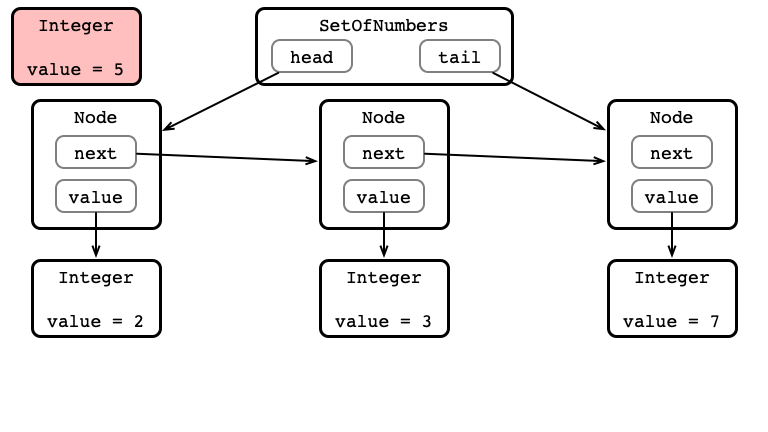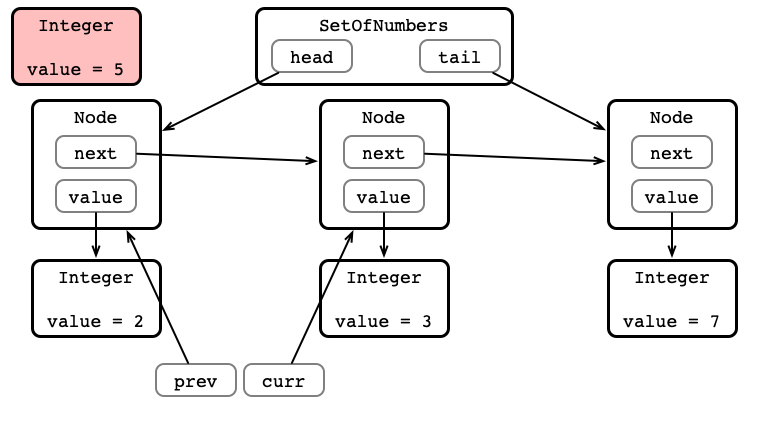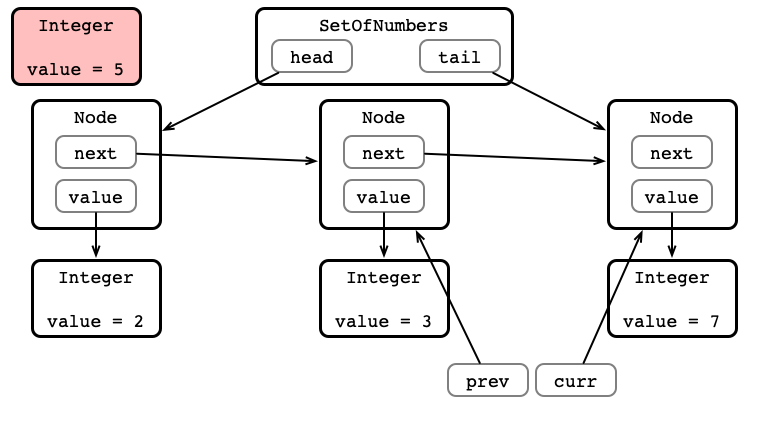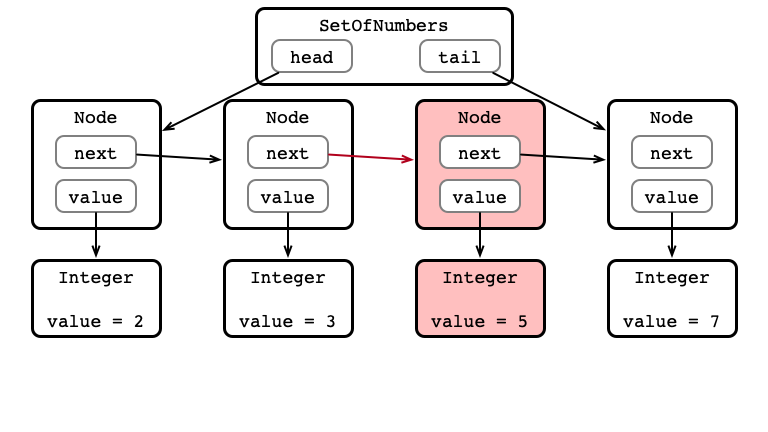Lecture 18: Interfaces
Overview
- Finishing Up Generics
- Comparing Items
- Interfaces
Last Time
Made our linked list generic:
- can be used to store any specified type of object
- each instance only stores one type
- Java checks that correct types are used
Generic Syntax
Declare class with a type, T:
public class GenericList<T> {
...
}
Inside the class, T can be used like a variable representing the type:
// add an item of type T
public void add (T item) {
...
}
// get next item of type T
public T next () {
...
}
Better Code with Generics
Now we can use the same GenericList to store any type of object:
GenericList<Animal> zoo = new GenericList<Animal>();
GenericList<Person> school = new GenericList<Person>();
GenericList<Integer> numbers = new GenericList<Integer>();
...
Iterating over the List
We also implemented methods for iteration:
-
hasNext()returnstrueif there is another element in the list -
next()returns the next element in the list
To access all the elements in the list:
while (zoo.hasNext()) {
Animal a = zoo.next();
...
}
Adding Items
public void add (T item) {
Node nd = new Node(item);
if (tail != null) {
tail.setNext(nd);
tail = nd;
} else {
head = nd;
tail = nd;
iter = nd;
}
}
When we call list.add(item), the item is added to the end of the list
The Order of Things
Consider
GenericList<Integer> list = new GenericList<Integer>();
list.add(4);
list.add(2);
list.add(3);
while (list.hasNext()) {
System.out.println(list.next());
}
What does it print?
A Question
Suppose we wanted to store/print elements in sorted order:
SomeList<Integer> list = new SomeList<Integer>();
list.insert(4);
list.insert(2);
list.insert(3);
while (list.hasNext()) {
System.out.println(list.next());
}
We want to see output:
2
3
4
How might we accomplish this?
Sorted List

How Would We Insert 5?

Idea
Use procedure similar to remove method:
- store
prevandcurrnodes - iterate over list until
-
currvalue is at least5 -
prevvalue is smaller than5
-
- insert node storing value
5betweenprevandcurr
Insertion in Pictures

Insertion in Pictures

Insertion in Pictures

Insertion in Pictures

Insertion in Code
Special cases:
- inserted value is smallest
- update
head
- update
- inserted value is largest
- update
tail
- update
Insertion in Code
public void insert (T item) {
Node nd = new Node(item);
// check if empty
if (tail == null) {
head = nd; tail = nd; iter = nd;
return;
}
// check if insert at head
if (item <= head.item) {
nd.next = head; head = nd; iter = nd;
return;
}
Node prev = head;
Node curr = prev.next;
// find location to insert item: prev.item < item <= curr.item
while (curr != null && item > curr.item) {
prev = curr;
curr = curr.next;
}
// check if tail insert
if (curr == null) {
prev.next = nd; tail = nd;
return;
}
prev.next = nd;
nd.next = curr;
}
What is the Problem?
public void insert (T item) {
Node nd = new Node(item);
if (tail == null) {
head = nd; tail = nd; iter = nd;
return;
}
if (item <= head.item) {
nd.next = head; head = nd; iter = nd;
return;
}
Node prev = head;
Node curr = prev.next;
while (curr != null && item > curr.item) {
prev = curr;
curr = curr.next;
}
if (curr == null) {
prev.next = nd; tail = nd;
return;
}
prev.next = nd;
nd.next = curr;
}
Requirement
In order to store a sorted collection, must be able to compare pairs of elements.
- compare numbers by value
- compare
Strings alphabetically - compare
Animals by…- …species?
- …name?
- …age?
Limitation
It doesn’t make sense to compare everything!
Goals:
- Specify that a particular type of object does support comparisons
- need means of signalling that a
classsupports comparison
- need means of signalling that a
- Require that only objects that can be compared are stored in a
SortedList- otherwise, sorting doesn’t make sense
Interfaces
What is an Interface?
A way of specifying what a class can/must do
- specify functionality
- does not specify implementation
- a class providing required functionality implements the interface
- may be many possible ways to implement an interface
The Comparable Interface
Java defines the Comparable<T> interface:
For a class to be Comparable it must have a method
public int compareTo(T o)
Comparable Semantics
If a and b are Comparable objects:
- if
a.compareTo(b)is less than0, thenais “smaller than”b - if
a.compareTo(b)is greater than0, thenais “larger than”b - if
a.compareTo(b)is0then they are treated as equal
Classes Implementing Comparable
-
Integer,Double, …- compare numerical values as you’d expect
-
String- compare alphabetically
Making Animals Comparable
To implement an interface, must:
- Declare that class implements the interface:
public class Animal implements Comparable<Animal> { ... } - Implement the methods required by the interface
public class Animal implements Comparable<Animal> { ... public int compareTo(Animal a) { ... } }
A Question
How should we compare two Animals?
Let’s Implement!
Back to our Sorted List
Create a new class SortedList
- stores elements as in our
GenericList - elements in sorted order
- elements must implement
Comparable
A new declaration:
// T a generic type, but must implement the Comparable<T>
// interface
public class SortedList<T extends Comparable<T>> {
...
}
Implementing and Testing SortedList
Why Interfaces?
An interface is a contract:
- In order to implement the
interface, you must provide certain functionality - If you provide that functionality, I can write code that uses the functionality to perform some task
- I don’t need to know how you provide functionality
Sorting example:
- We wrote code to store a sorted list of items
- Works for any class implementing
Comparable - The
classdetermines what is meant by comparison
Good Design
Separate interface from implementation
- Better encapsulation
- Explicit functionality of the class
- Explicit requirements to use existing functionality
- Can provide different implementations of same interface
- sort by species/name? sort by age? by height?
- different implementations might be appropriate for different contexts